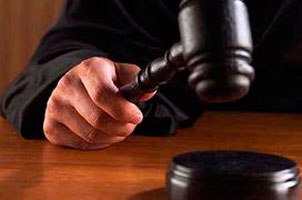Trial of Vasil Parfiankou: Analysis
On 17 February 2011, Minsk Frunzenski Court chaired by Judge Ms. Volha Komar with participation of prosecuting official Anton Zaharouski considered the case of Vasil Pafiankou, accused of committing a crime under Par. 2 Art. 293 of the Criminal Code of the Republic of Belarus – “mass riot”. It was a first trial of the participants of the 19 December peaceful post-election protest rally.
At the beginning of the trial, the Presidential Administration laid a civil suit, supported by the Administration’s representative Mr. Lepesh. From the outset, the complainant’s representative presented papers on the calculation of damages inflicted by the participants of the rally against state property, estimated at BYR 14,144,000. It should be noted that the prosecuting indictment mentioned an amount of BYR 29 mln. Thus, by the begging of the trial, the amount of damage had been reduced by over two times.
After clarifying the plaintiff’s claim, the court proceeded to the consideration of the case.
In his speech, the state attorney confined himself to formal announcing of the indictment, which suggested that Vasil Pafiankou took part in the mass riot in Minsk’s Nezalezhnastsi Square on 19 December 2010 and, together with other persons, hit for at least 61 times the doors of the Government House building. Apart from that, the prosecutor’s speech suggested that Mr. Pafiankou was charged with armed resistance against law-enforcement officials.
Vasil Parfiankou partially admitted his guilt, but only in taking part in the peaceful protest rally, however he did not admit that he allegedly participated in rioting and armed resistance.
The state attorney based his accusation on the investigative materials solely, including video coverage of the rally.
After that the court proceeded to the examination of Mr. Parfiankou.
During the examination, Mr. Parfiankou explained that he had been activist of Uladzimir Niakliayeu’s campaign team. He dwelt on the signature-gathering procedures, he also said that during the canvassing campaign he had distributed election materials of Uladzimir Niakliayeu’s team. Mr. Parfiankou explained that he had come to the Square to express his civil stance. He also said that the decision had been personal.
Mr. Parfiankou spoke about an incident on 19 December 2011 when at about 7 p.m. he was among the supporters of Uladzimir Niakliayeu outside the office of “Speak the Truth” civil campaign. He said that the demonstrators had been attacked by unknown persons in black clothes, who made everyone lie down with their faces to the ground and beat up the presidential candidate Uladzimir Niakliayeu, damaged the bus belonging to his team.
After the unconscious Mr. Niakliayeu was taken to the campaign’s office, Mr. Parfiankou, together with other activists proceeded to Kastrychnitskaya Square, where he took part in the manifestation towards Nezalezhnastsi Square. Mr. Parfiankou repeatedly stressed that he had not heard any warnings by the police, nor had he seen any iron rods, wooden bats or other tools for violent actions among the demonstrators. He stated that the only thing the protesters held in their hands were the flags of various campaigns and pro-democratic movements.
During the candidates’ addresses at Nezalezhnastsi Square, he heard the sound of broken glass and approached the doors of the Government House out of curiosity, where he reportedly saw that the glass of the doors had been broken, he was pressed among the crowd of unknown persons who knocked on the broken doors blocked by something similar to filing cabinets. The actions were supported by no more than 20-30 persons. Mr. Parfiankou himself, being carried away by the crowd, hit the wooden fence with his hands and feet.
Mr. Parfiankou also said that the presidential candidate Rymasheuski had approached the rioting group with a demand to stop, then presidential candidates Sannikau and Statkevich managed to come up and demanded to stop the riot as well. Then Mr. Parfiankou also tried to keep the rioters under control. Thus, Mr. Parfiankou testified that the presidential candidate did not intend to organize a riot, but did their best to suppress a small group of persons, who provoked the violence.
Mr. Parfiankou also stressed that he had not seen any iron rods or other tools for violent actions among the demonstrators. After the riot police appeared, Mr. Parfiankou left the Square.
After Parfiankou’s examination, witness Mr. Fabisheuski (another activist of Uladzimir Niakliayeu’s campaign team) was examined. Mr. Fabisheuski, as well as another witness Mr. Yalovik could neither prove nor rebut Mr. Parfiankou’s participation in the rally, since they had not seen him there.
After that, the court examined the written materials of the case and watched several videos. The videos, that to a great extent failed to describe Mr. Parfiankou’s behaviour, showed that he, with no arms or tools in his hands, had hit the wooden fence for a couple of times. The video evidence failed to prove that he had tried to penetrate the building. The video also showed that the rioting lasted for a few minutes and was committed by a small group of persons.
The video evidence also showed a number of spade handles, ice choppers, iron rods and a stun grenade, allegedly left by the protesters, however it was impossible to establish who had used them or prove that it was Vasil Parfiankou. The majority of the objects had no fingerpints at all. It should be observed that a criminalistics expert examination failed to consider the objects as offensive weapons, as all of them are of industrial manufacture.
After that, the court considered a civil suit, when the plaintiff’s representative said that the calculation of the damage had registered a damage inflicted to the doors of the Government House, a rain-pipe and five shrubs of juniper.
Then a closed session of the court examined Mr. Parfiankou’s mobile short message service records. The closed character of the session was reportedly due to privacy reasons.
Then the court opened the arguments.
The state prosecutor argued that Mr. Parfiankou had taken part in the mass riot, hitting the wooden fence for at least 60 times. This was allegedly testified by the videos and other materials of the case.
As a result, he, mentioning a previous sentence to Mr. Parfiankou, which had not been removed from official records, and poor behaviour, the prosecutor, considering the crime repetition, demanded 6 years of imprisonment for the accused.
Mr. Parfiankou’s counsel explained that his client’s actions, as well the actions of other protesters, had no elements of the crime under Art. 293 of the Criminal Code, that Mr. Parfiankou’s actions were in no way violent, since they were short-time, were not accompanied with arson or armed resistance to law-enforcement officials. Nor was it proven by the court that Mr. Parfiankou had entered into a criminal conspiracy with other persons, nor did he intend to damage the property or attack the policemen. Therefore, the counsel demanded to acquit the defendant.
Mr. Parfiankou himself said he was sorry for his actions and asked not to punish him in a severe way.
An hour an a half later the judge pronounced her verdict, which found Mr. Parfiankou guilty of committing an offence under Par. 2 Art. 293 of the Criminal Code, manifested by participation in mass riots together with uncontrollable crowds and hitting the fence of the Government House. The judge dismissed the charges of armed resistance and arson by Mr. Parfiankou. The judge sentenced Vasil Parfiankou to four years of imprisonment and fully satisfied the claims for damage recovery.
After the pronunciation of the verdict, the counsel said that he was going to appeal the sentence.
Conclusions:
- The court sessions failed to establish any evidence that Mr. Parfiankou had taken part in the mass riot, to provide explanations why it accused Mr. Parfiankou of criminal conspiracy with other persons, to prove that Mr. Parfiankou had broken the glass doors, attacked the policemen and called upon other citizens to attack the government building.
- Human rights defenders believe that, having dismissed the charges of armed resistance, with no evidence of violence used by Mr. Parfiankou, the court should have acquitted the accused.


















